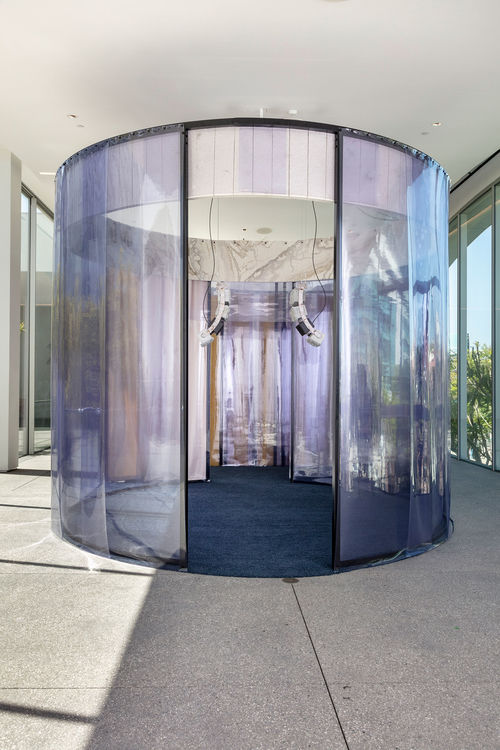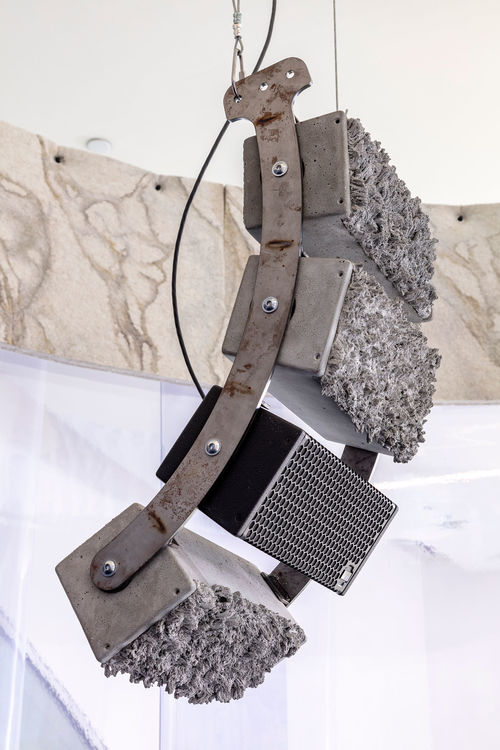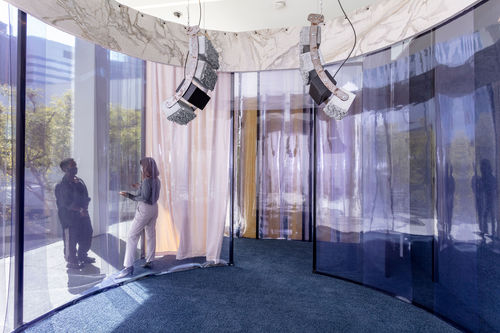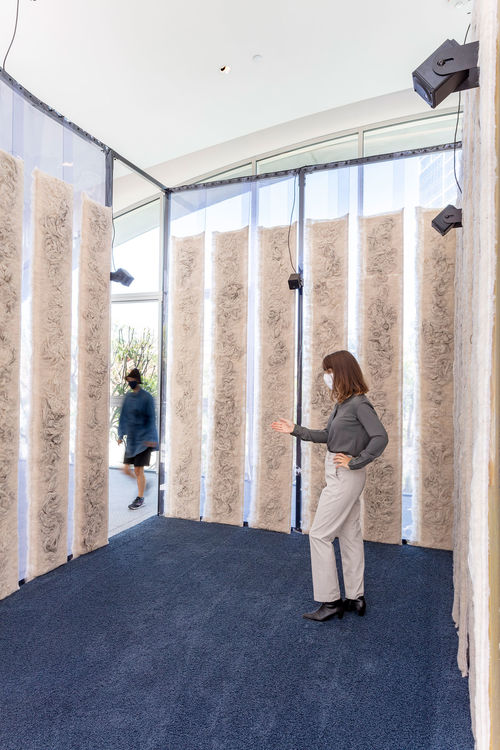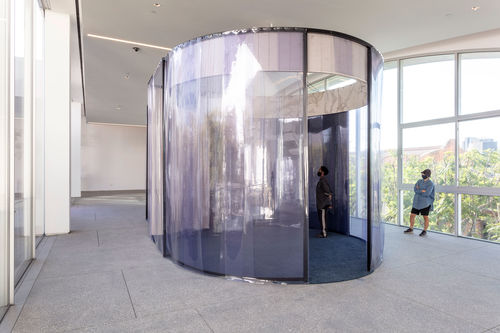
Jacqueline Kiyomi Gork
Jacqueline Kiyomi Gork’s work is rooted in her intuitive sensitivity to systems of feedback and sound in the built environment. After an encounter with the minimalist composer La Monte Young’s Dream House in 2002, Gork—also trained in dance—began connecting her penchant for movement with what she was hearing. The artist cultivates this embodied knowledge through sound installation, sculpture, and performance that together aim at reconfiguring the traditional hierarchies between audience, performer, and architecture. This blurring begins with her materials, which double as her subject: speakers, soundproofing curtains, and even performers are both the architecture of the work and its point of inquiry. The specter of dance and sound looms over this material back-and-forth, with Gork regularly considering the choreographic potential of acoustic experience—whether pop music or deep listening—in challenging how we encounter art.
Gork’s durational performance and immersive sound installation explore speech and conversation and the way the listener’s affects and desires can transform what’s being heard. The work relates to her ongoing interest in sonic experience and language, identifying what speech is and how meaning and interpretation change based on how information is delivered. Comprising two interconnected rooms, separated by handmade plastic and felt curtains, the sound-resistant environment helps to create distinct acoustic and visual effects as performers move throughout the spaces reciting an AI-generated text culled from various forms of public speech. The performers have been coached in gestures and body movements intrinsic to public speaking, but as each body is unique, performers utilize this information according to their own agency. Visitors are invited to move through each room along with the performers. The installation blurs the lines between frame and content, with the sound system, curtains, and even performers and visitors serving as both material and subject of the work.
The creation of this work is made possible by a generous contribution from VIA Art Fund.
In Made in L.A. 2020: a version, the artist’s work is present in two institutions, across Los Angeles. See Jacqueline Kiyomi Gork's work on view at The Huntington.
the input of this machine is the power an output contains by Jacqueline Kiyomi Gork
in creation with:
Performers: Nour Mobarak, Mikki Yamashiro, Dawn Garcia, and Micah James
Text generation: Rose Meyers using Open AI's GPT-2 117M and various speeches
Software designer: Sam Hertz
Custom audio processing: Jonathan S. Abel, Center for Computer Research in Music and Acoustics (CCRMA), Stanford University
Speech editor: Wendy Univer
Fabrication assistance: Sohyeon Jenny Eom, Alee Peoples, Bashir Naim
Metal fabrication: Ron Yeung
Audio equipment courtesy of Meyer Sound, Berkeley, CA
Download the written score for the spoken word in this artwork. (PDF, 4pp., 71KB)
Performers used this score as the basis for their improvisation during the performance.
Biography
Jacqueline Kiyomi Gork was born in 1982 in Long Beach, California. Gork completed academic stints at San Francisco Art Institute and Stanford University, where she studied the history of communication technologies, acoustics, and computer music. After an encounter with the minimalist composer La Monte Young’s Dream House in 2002, Gork began connecting her penchant for movement with what she was hearing. Following this tack, she threw herself into the work of Merce Cunningham and John Cage and the creative methodology of Anna Halprin as a way of reckoning with the potential for collaboration between dance and other genres, such as music and sound. Gork cultivates this hybrid tutelage through sound installation, sculpture, and performance that together aim at reconfiguring the traditional hierarchies between audience, performer, and architecture. This blurring of engagement begins with Gork’s materials, which also double as her subject: speakers, soundproofing curtains, and even performers are both the architecture of the work and its source of inquiry. The specter of dance and sound looms over this material back-and-forth, with Gork regularly considering the choreographic potential of acoustic experience—from pop music to deep listening—in challenging existing modes of engagement with art. Gork’s work has been the subject of solo exhibitions at Empty Gallery, Hong Kong (2017); 356 Mission, Los Angeles (2017); Western Front, Vancouver (2016); The Lab, San Francisco (2016); and Yerba Buena Center for the Arts, San Francisco (2016), among others. She has participated in group exhibitions at San Francisco Museum of Modern Art (2017); V-A-C Foundation, Moscow (2018); Mills College Art Museum, Oakland (2015); Institute of Contemporary Arts, London (2012); and Berkeley Art Museum and Pacific Film Archive (2011), among others.



